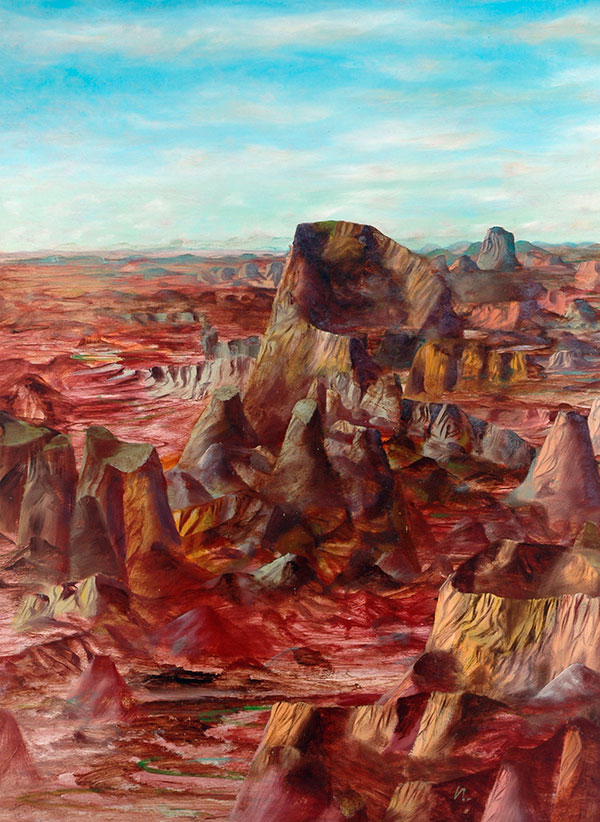Sidney Nolan: artist of terrain and torment

Simply sign up to the Life & Arts myFT Digest -- delivered directly to your inbox.
Off to one side of a cold, blue-grey seascape, a tiny boat is sinking. With a few brushstrokes and a red-brown smudge, Sidney Nolan captures the final moments of Benjamin Britten’s opera Peter Grimes, when Grimes, his hopes shattered, ends his life at sea.
The painting comes as a surprise in the context of a new exhibition at Australia House, London, to mark the centenary of Nolan’s birth. Created in 1977, a year after his friend Britten’s death, it seems a long way from the works mythologising the 19th-century outlaw Ned Kelly and the parched Australian landscapes the artist is famous for.
The Australia House show is part of a year-long series of UK exhibitions and events co-ordinated by the Sidney Nolan Trust. With rather less fanfare, two of Australia’s museums, where many of Nolan’s vast oeuvre of 30,000 works are on permanent display, have this week unveiled special displays drawn from their own collections. At the Art Gallery of New South Wales this includes the eerie “Hare in Trap” (1946) and the surreal “Pretty Polly Mine” (1948), while the National Gallery of Victoria is bringing together 25 groundbreaking paintings inspired by Nolan’s discovery of the harsh west Victorian landscape, when he was stationed in Wimmera during the second world war.
In the UK, in a superb display of Nolans from British collections at Chichester’s Pallant House, we find the artist developing his narratives from the 1940s a decade or two later: Ned Kelly, the explorers Burke and Wills, and Mrs Fraser, the shipwrecked woman rescued by a convict, re-emerge as tiny figures all but obscured by landscape. Here, too, are the convulsed carcases of dead animals, based on photographs Nolan took of the Queensland drought in the 1950s. And a second work from the Britten series: “Peter Grimes’s Apprentice”, a magical depiction of the drowning boy that manages to suggest that his soul is ascending, even as he descends to the depths.


Nolan left Australia, aged 36, in 1953 and based himself in Britain until his death in 1992. But he travelled constantly, to Greece, then America, Africa and Antarctica, each place prompting a new painting series — as did Australia, to which he returned again and again. Aside from the odd painting of the Thames, the fictional world of Peter Grimes, evoking the steely grey seas off the Suffolk coast, is the closest he came to making Britain his subject matter.
Even when, late in life, he settled down as a gentleman farmer on the Welsh border, his art had nothing to do with Britain. “He seemed completely at home . . . exhibiting his prize cattle, but his art was exotic — a world away,” says novelist Simon Mundy, in an introduction to Nolan written for the centenary events. “Those of us that were local friends found the Australian work interesting — often beautiful — but alien, and it seemed strange that it had been made by the man we knew as a neighbour.”
The son of a Melbourne tram driver was by then a knight of the realm. Nolan had joined the British establishment, yet he continued to regard himself as an Irish rebel and his head was still full of Australia. In June, Birmingham’s Ikon Gallery will exhibit a series of startling portraits from the 1980s, some of them a response to the continuing deaths of Aboriginal people in Australian jails.

These fascinating works on show around Britain give a taste of Nolan. But to grasp the artist fully requires a trip to the Heide Museum of Modern Art, near Melbourne. Heide was the home of John and Sunday Reed, bohemian art patrons whom Nolan met as a shy, mumbling but ambitious young artist in 1938.
The intense, nine-year ménage-à- trois that followed gave rise to the work that in 1949 caught the eye of Kenneth Clark (former director of London’s National Gallery) and set Nolan on the road to international recognition and a place in the top tier of Australia’s 20th-century artists. The first Ned Kelly series, all but one of which were painted on the Heide kitchen table, grew out of Nolan’s passionate love affair with Sunday Reed, as did the Wimmera paintings. But by the time the Kelly paintings (which now have a room of their own at the National Gallery in Canberra) were shown in 1948, Nolan had cut loose and did his best to airbrush the Reeds out of his life. Sunday never got over it; the fact that the affair resurfaced more than 20 years later in cruel poems he wrote to accompany his “Paradise Garden” series suggests that Nolan didn’t either.

There’s usually an autobiographical strand to Nolan’s work and two late self-portraits are particularly revealing. Ikon will show one in which he has blacked out his eyes with a spray-painted line — but its companion work at Pallant House, in which Nolan’s haunted eyes are trapped in the black outline of a Ned Kelly helmet, is even more unsettling. You can’t help feeling that the Australia that lived on in Nolan’s mind was a place riven with guilt and anguish.
‘Unseen: Works from Sidney Nolan
Trust Collection’, Australia High Commission, London, April 21-May 5, sidneynolantrust.org; ‘Transferences: Nolan in Britain’,
Pallant
House, Chichester, to June 4, pallant.org.uk;
‘Sidney Nolan’, Ikon Gallery, Birmingham, June 10-September 3, ikon-gallery.org
Comments